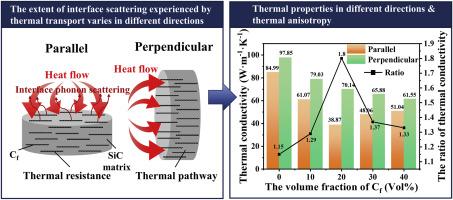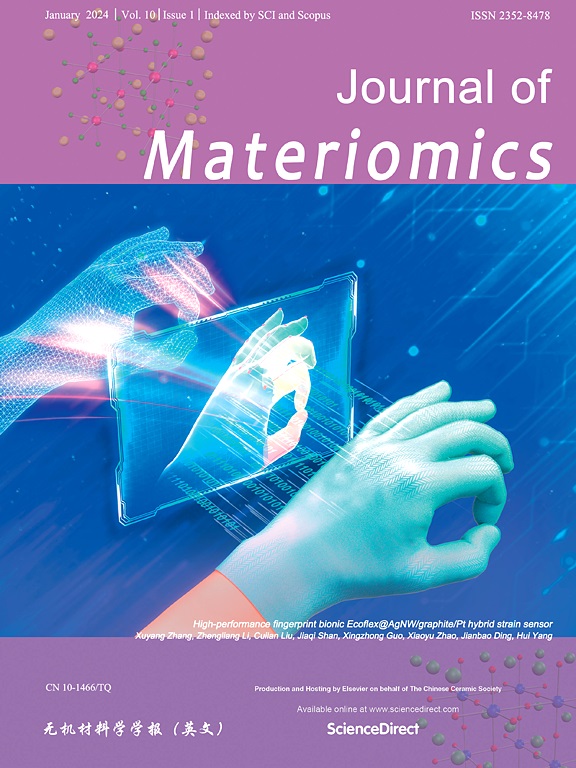激光打印和聚合物渗透热解技术制备短切Cf增强SiC复合材料的热各向异性
IF 9.6
1区 材料科学
Q1 CHEMISTRY, PHYSICAL
引用次数: 0
摘要
定向热传输材料可以实现各向异性热流,从而提高热管理系统的效率。这些材料在航空航天、电子和汽车工业中得到了广泛的应用。碳化硅(SiC)基复合材料具有优异的性能,包括高模量、热稳定性和优越的导热性,是理想的结构材料。通过对微观结构和成分的策略性控制,实现了定向热管理,扩大了热管理的适用性,实现了结构功能的整合。通过将选择性激光打印与前驱体浸没和热解(PIP)相结合,本研究提出了一种创新的方法来制造具有结构和功能特性的热各向异性Cf/SiC复合材料。优化后的复合材料(体积比例为20%)具有较高的纤维取向性(fp = 0.7677)和明显的热各向异性,在印刷平面垂直和平行方向的导热系数分别为70.14 W/(m·K)和38.87 W/(m·K)(各向异性比为1.8)。这种通过光纤定向和声子散射控制实现的定向热传输对于先进的热管理至关重要。该复合材料还保持了良好的机械强度,平行于打印平面的弯曲强度为(150.4±9.8)MPa,最终实现了结构和功能的一体化。本文章由计算机程序翻译,如有差异,请以英文原文为准。

Thermal anisotropy in chopped Cf reinforced SiC composites by laser printing and polymer infiltration-pyrolysis techniques
Directional thermal transport materials enable anisotropic heat flow, thereby enhancing the efficiency of thermal management systems. These materials have found broad applications in aerospace, electronics, and automotive industries. Silicon carbide (SiC) based composites, with their exceptional properties including high modulus, thermal stability, and superior thermal conductivity, serve as an ideal structural material. Strategic manipulation over microstructure and composition enables directional thermal management, expanding applicability in thermal management and achieving structural-functional integration. By combining selective laser printing with precursor impregnation and pyrolysis (PIP), this work presents an innovative approach to fabricating thermally anisotropic Cf /SiC composites that integrate both structural and functional properties. The optimized composite (20% (in volume) chopped Cf ) exhibited high fiber alignment (f p = 0.7677) and pronounced thermal anisotropy, with thermal conductivities of 70.14 W/(m·K) perpendicular and 38.87 W/(m·K) parallel to the printing plane (anisotropy ratio: 1.8). This directional heat transport, enabled by fiber orientation and phonon scattering control, is critical for advanced thermal management. The composite also maintained good mechanical strength, exhibiting a flexural strength of (150.4 ± 9.8) MPa parallel to the printing plane, finalizing in a structural and functional integration.
求助全文
通过发布文献求助,成功后即可免费获取论文全文。
去求助
来源期刊

Journal of Materiomics
Materials Science-Metals and Alloys
CiteScore
14.30
自引率
6.40%
发文量
331
审稿时长
37 days
期刊介绍:
The Journal of Materiomics is a peer-reviewed open-access journal that aims to serve as a forum for the continuous dissemination of research within the field of materials science. It particularly emphasizes systematic studies on the relationships between composition, processing, structure, property, and performance of advanced materials. The journal is supported by the Chinese Ceramic Society and is indexed in SCIE and Scopus. It is commonly referred to as J Materiomics.
 求助内容:
求助内容: 应助结果提醒方式:
应助结果提醒方式:


